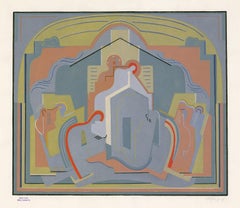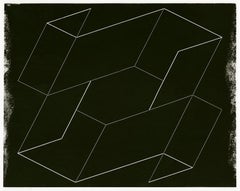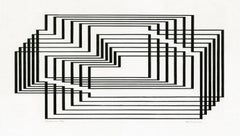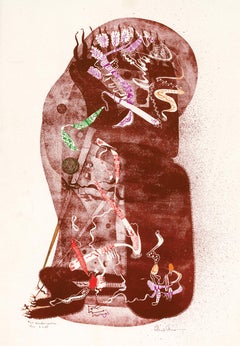Want more images or videos?
Request additional images or videos from the seller
1 of 8
Jacques Villon'Femme Cubiste, 1914' — Artist signed lithograph, after the Cubist Masterpiece1914/1962
1914/1962
Price:$1,400
$1,600List Price
About the Item
- Creator:Jacques Villon (1875-1963, French)
- Creation Year:1914/1962
- Dimensions:Height: 23 in (58.42 cm)Width: 11 in (27.94 cm)
- Medium:
- Movement & Style:
- Period:
- Condition:
- Gallery Location:Myrtle Beach, SC
- Reference Number:Seller: 1032511stDibs: LU532314955852
Jacques Villon
Jacques Villon was born Gaston Duchamp in 1875. He was the oldest brother of the artists Marcel Duchamp, Suzanne Duchamp-Crotti and the sculptor Raymond Duchamp-Villon. Initially a law student, in 1894 he went to Paris to study art. It was there that he met Henri Toulouse-Lautrec and other influential artists in Paris, and changed his name to Jacques Villon, after the poet. Villon made prints of some of the most well-known belle-époque portraits and genre scenes of the early twentieth century. Around 1911, he came under the influence of Picasso and other cubists, and became a leading exponent of the style, exhibiting in the 1913 Armory Show in New York. In 1922, the Galerie Bernheim-Jeune commissioned Villon to produce a series of color aquatints after 38 major nineteenth- and twentieth-century paintings. This series included works by Pierre Auguste Renoir, Henri Matisse, Pablo Picasso, Paul Cezanne, Georges Braque, Raoul Dufy, Amadeo Modigliani, Edouard Manet, Pierre Bonnard, and others. Artists who were alive at the time of the printing collaborated with Villon, and signed the prints. The project took ten years to complete. Several of these prints are valued highly today, and some went on to be reproduced by the Louvre Museum as photo-etchings. Villon's 'cubist' etchings, with their characteristic cross-hatching, are amongst the most renowned prints of the twentieth century. Jacques Villon's long career brought him fame. The diverse nature of his paintings, from end-of-the-century portraits to cubist and abstract styles to graphic works, made him a major figure in twentieth-century art. He was made a Grand Officer of the Légion d'Honneur, and upon his death in 1963, and he was given a state funeral.
About the Seller
5.0
Recognized Seller
These prestigious sellers are industry leaders and represent the highest echelon for item quality and design.
Platinum Seller
Premium sellers with a 4.7+ rating and 24-hour response times
Established in 1995
1stDibs seller since 2016
333 sales on 1stDibs
Typical response time: 1 hour
Associations
International Fine Print Dealers Association
Authenticity Guarantee
In the unlikely event there’s an issue with an item’s authenticity, contact us within 1 year for a full refund. DetailsMoney-Back Guarantee
If your item is not as described, is damaged in transit, or does not arrive, contact us within 7 days for a full refund. Details24-Hour Cancellation
You have a 24-hour grace period in which to reconsider your purchase, with no questions asked.Vetted Professional Sellers
Our world-class sellers must adhere to strict standards for service and quality, maintaining the integrity of our listings.Price-Match Guarantee
If you find that a seller listed the same item for a lower price elsewhere, we’ll match it.Trusted Global Delivery
Our best-in-class carrier network provides specialized shipping options worldwide, including custom delivery.You May Also Like
Theogonie Exhibition Poster by Georges Braque, Modernist Mourlot Lithograph 1959
By (after) Georges Braque
Located in Chicago, IL
"Galerie Maeght Theogonie" announces an exhibition of the drawings Georges Braque produced to illustrate "Theogony", the 7th century BCE work by Hesiod that narrates the birth of the...
Category
Mid-20th Century Cubist Abstract Prints
Materials
Lithograph
Cubist Exhibition Poster by Georges Braque, Modernist Mourlot Lithograph, 1959
By (after) Georges Braque
Located in Chicago, IL
"Exhibition G. Braque" features one of Georges Braques' favorite subjects: a bird in flight. The poster announces an exhibition of Braques works held at the Royal Scottish Academy in...
Category
Mid-20th Century Cubist Abstract Prints
Materials
Lithograph
$315
H 12.5 in W 9.375 in
Graphic Artwork Exhibition Poster by Georges Braque, Modernist Lithograph 1959
By (after) Georges Braque
Located in Chicago, IL
"Georges Braque Graphic Works" features a bird in flight against a ruddy background. The poster announces an exhibition of prints and illustrated books held at Galerie Nicolas Rauch ...
Category
Mid-20th Century Cubist Abstract Prints
Materials
Lithograph
$315
H 12.5 in W 9.375 in
Picasso and The Weeping Women, Metropolitan Museum exhibition poster, on linen
By (after) Pablo Picasso
Located in Spokane, WA
Picasso and the Weeping Woman — 1994 Metropolitan Museum of Art Exhibition Poster (Linen-Backed). Grade A- condition. Size is 40” x 37.5”. The painting’s original name is “The Pa...
Category
1990s Cubist Portrait Prints
Materials
Lithograph
$950
H 39.75 in W 37.5 in D 0.3 in
Homme couche et femme accroupie
By Pablo Picasso
Located in Fairlawn, OH
Homme couche et femme accroupie
Lithograph on Arches paper, 1956
Signature stamp lower right )see photo)
Annotated in pencil lower left: "epreuve d'artiste" (see p[hoto)
Edition: 50...
Category
1950s Cubist Abstract Prints
Materials
Lithograph
1956 Fernand Leger Mourlot Exhibition Poster
By Fernand Léger
Located in Wilton Manors, FL
76 x 52 cm. Printed by Fernand Mourlot on rag paper watermarked "Mourlot." A condition. Not in Saphire. .Fernand Mourlot was born in Paris in 1895. He grew up in the family print shop but it wasn't until he took over in the early 1920s that he would change the fabric of printing forever. His influence fostered a resurgence of lithography, revealing it as a new avenue for expression and a new realm of possibilities for likes of Pablo Picasso, Henri Matisse, Marc Chagall, Joan Miró, Georges Braque, Fernand Léger, and Alberto Giacometti to enrich their own work as well as fine art in general. Fernand cultivated the lithograph as a painter's medium and the family studio on Rue Chabrol became a hub where he could invite artists to work directly on the stone, as if creating a poster. In 1937, the studio produced two posters (based on paintings by Matisse...
Category
Mid-20th Century Cubist Abstract Prints
Materials
Paper, Lithograph
$680 Sale Price
20% Off
H 30 in W 20.5 in
Cubist Composition, Lithograph by Jean Helion
By Jean Hélion
Located in Long Island City, NY
Jean Hélion was a French painter (1904 - 1987) whose abstract work of the 1930's established him as a leading modernist. His mid-career rejection of abstraction was followed by nearl...
Category
1930s Cubist Abstract Prints
Materials
Lithograph
Large Cubist Modernist Color French Lithograph Zadkine Figures La Famille
By Ossip Zadkine
Located in Surfside, FL
Ossip Zadkine (French-Russian, 1890-1967),
limited edition color lithograph on paper titled La Famille (The Family), depicting intertwined figures in a Cubist-inspired style. The pr...
Category
1960s Cubist Figurative Prints
Materials
Lithograph
$1,600
H 30 in W 22.25 in
"Braque Graveur, " Lithograph Poster signed in the stone
By Georges Braque
Located in Milwaukee, WI
"Braque Graveur" is an original color lithograph poster. It depicts a moth or butterfly landed on a black abstract form. There are blue and reddish-brown abstract shapes as well, and...
Category
1950s Synthetic Cubist Abstract Prints
Materials
Lithograph
Golgotha
By Jacques Villon
Located in San Francisco, CA
Artist: Jacques Villon (French, 1875-1963)
Title: Golgotha
Year: 1956
Medium: Color lithograph
Edition: Numbered 74/80 in pencil
Paper: Rives
Image size: 25.25 x 18.5 inches
S...
Category
Mid-20th Century Cubist Figurative Prints
Materials
Lithograph
More From This Seller
View All'Descente de Croix' (Descent from the Cross) — 1920s French Cubism
By Albert Gleizes
Located in Myrtle Beach, SC
Albert Gleizes, 'Descente de Croix', color pochoir, 1928, edition c. 50. Signed and dated in pencil. A fine, painterly impression, with fresh colors, on heavy, cream wove paper; the full sheet with margins (3 to 4 inches), in very good condition. The publisher's ink stamp 'EDITIONS MOLY-SABATA' beneath the image, lower left. Matted to museum standards, unframed.
Image size 12 x 14 inches (305 x 356 mm); sheet size 18 x 22 inches (457 x 559 mm).
ABOUT THE IMAGE
After the 1927 painting 'Descente de Croix', one of three religious-themed works that Gleizes developed as preliminaries for murals at the church at Serrières, France, the project was terminated at its final phase, and Gleizes commissioned master printer Robert Pouyaud to create prints of the paintings, closely overseeing the production.
ABOUT THE MEDIUM
Pochoir is a refined stencil-based technique employed to create multiples or to add color to prints produced in other mediums. Characterized by its crisp lines and rich color, the print-making process was most popular from the late 19th century through the 1930s, with its center of activity in Paris. The pochoir process began with the analysis of an image’s composition, including color tones and densities. The numerous stencils (made of aluminum, copper, or zinc) necessary to create a complete image were then designed and hand-cut by the 'découpeur.' The 'coloristes' applied watercolor or gouache pigments through the stencils, skillfully employing a variety of different brushes and methods of paint application to achieve the desired depth of color and textural and tonal nuance. The pochoir process, by its handcrafted methodology, resulted in the finished work producing the effect of an original painting, and in fact, each print was unique.
ABOUT THE ARTIST
Albert Gleizes (1881-1953), born in Paris, France, was a pioneering figure in the development of abstract art and one of the leading proponents of Cubism. His contributions to the art world extended beyond his paintings; he was also a prolific writer and theoretician, advocating for a new approach to art that emphasized the geometric abstraction of form and a departure from representational traditions.
Gleizes initially studied painting at the Académie Julian and the École des Beaux-Arts in Paris, where he was exposed to the academic conventions of the time. However, his artistic vision was profoundly influenced by encounters with avant-garde movements, including Fauvism and the work of Paul Cézanne. These influences led Gleizes to experiment with form and color, gradually moving away from traditional representation toward a more abstract and geometric style.
After completing his secondary schooling, Gleizes spent four years in the French army and then began pursuing a career as a painter, primarily doing landscapes. Initially influenced by the Impressionists, he was only twenty-one years of age when his work titled ‘La Seine à Asnières’ was exhibited at the Société Nationale des Beaux-Arts in 1902. The following year, he was part of the first Salon d'Automne and soon came under the influence of Fernand Léger, Robert Delaunay, Jean Metzinger, and Henri Le Fauconnier. In 1907, Gleizes and some of his friends pursued the idea of creating a self-supporting community of artists that would allow them to develop their art free of any commercial concerns. For nearly a year, Gleizes , with other painters, poets, musicians, and writers, lived at a large house in Créteil, but a lack of funds forced them to give up their facility in early 1908, and Gleizes moved temporarily into La Ruche, the artist commune in the Montparnasse Quarter of Paris.
In the early 1910s, Gleizes became associated with the Cubist movement, which was spearheaded by artists such as Pablo Picasso and Georges Braque...
Category
1920s Cubist Abstract Prints
Materials
Stencil
'Interlinear K50' — Mid-Century Geometric Abstraction
By Josef Albers
Located in Myrtle Beach, SC
Josef Albers, 'Interlinear K50', zinc plate lithograph offset to stone printing, 1962, edition 20, Danilowitz 151. Signed, titled, dated, and numbered '14/20' in pencil. A superb, ri...
Category
1960s Abstract Geometric Abstract Prints
Materials
Lithograph
$9,000 Sale Price
25% Off
'Interim' from the series 'Graphic Tectonics' —Mid-Century Geometric Abstraction
By Josef Albers
Located in Myrtle Beach, SC
Josef Albers, 'Interim' from the series 'Graphic Tectonics', zinc plate lithograph, 1942, edition 30, Danilowitz 101. Signed, titled, dated, and numbered '3/30' in pencil. A fine imp...
Category
1940s Abstract Geometric Abstract Prints
Materials
Lithograph
'Kindergarten' — Mid-century American Surrealism
By Robert Vale Faro
Located in Myrtle Beach, SC
Robert Vale Faro, 'Kindergarten', color lithograph, 1945, edition 12. Signed, dated, titled, and numbered '99' and '5/12' in pen. A fine, richly-inked impression, with fresh colors, on heavy, coated off-white wove paper; the full sheet with margins (1/2 to 1 1/2 inch), in excellent condition. Scarce. Matted to museum standards, unframed.
Image size 13 1/2 x 7 9/16 inches (343 x 192 mm); sheet size 17 x 12 1/4 inches (432 x 311 mm).
ABOUT THE ARTIST
Robert Vale Faro (1902-1988) was a well-known modernist architect and artist associated with the Chicago Bauhaus. He received his degree in architecture and design from the Armour Institute in Chicago and worked at L'Ecole des Beaux-Arts, Paris, from 1924-27, where he was influenced by Harry Kurt Bieg and Le Corbusier. Upon his return to Chicago, Faro worked with the important modernist Chicago architects George and William Keck under Louis Sullivan.
Faro founded the avant-garde printmaking group Vanguard in 1945. The group counted Atelier 17 artists Stanley William Hayter, Sue Fuller, and Anne Ryan as New York members and Francine Felsenthal of Chicago. The Brooklyn Museum mounted a show of Vanguard artists' work in 1946, which subsequently toured several other institutions in the United States.
Faro's visionary graphics from the 1940s are a sophisticated blend of Abstract Expressionism, Surrealism, and Indian Space...
Category
1940s Surrealist Abstract Prints
Materials
Lithograph
#6 — Modernist Abstraction — African American Artist
Located in Myrtle Beach, SC
Hilliard Dean, '#6', color lithograph, 1970, edition 9. Signed, titled, and annotated 'Ed 9' in pencil. A fine impression, with fresh colors, on Arches, ...
Category
1970s Contemporary Abstract Prints
Materials
Lithograph
#3 — Modernist Abstraction — African American Artist
Located in Myrtle Beach, SC
Hilliard Reynolds Dean, '#3', color lithograph, 1970, edition not stated but small. Signed and titled in pencil. A fine impression, with fresh colors, on Arches, heavy, cream wove pa...
Category
1970s American Modern Abstract Prints
Materials
Lithograph
Recently Viewed
View AllMore Ways To Browse
Francois Villon
Suzanne Duchamp
Joan Miro Revolutions Sceniques Du Xxe Siecle I
Jorg Schmeisser
Josef Albers Yellow
Kandinsky And Etching
Kaws Snoopy
Krakow Vintage Poster
Lennart Nystrom
Lichtenstein Silkscreen
Luciano Castelli
Milan Lukac
Motherwell Africa Suite
Mourlot Corbusier
Pablo Eduardo
Pepe Tanzi
Peter Max Signed Flowers
Philip Guston Prints



